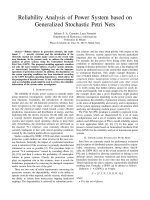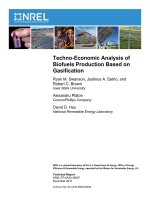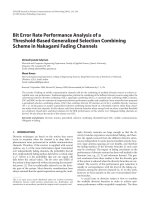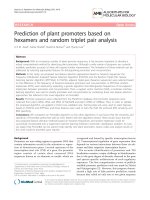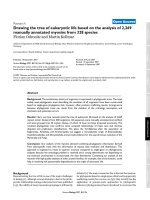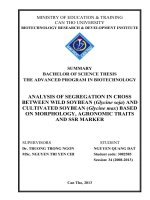Analysis of genotypic diversity based on leaf morphological traits in rockets (Eruca sativa)
Bạn đang xem bản rút gọn của tài liệu. Xem và tải ngay bản đầy đủ của tài liệu tại đây (699.59 KB, 6 trang )
Analysis of genotypic diversity based on leaf
morphological traits in rockets (Eruca sativa)
Zhi‐HaoXu1,Ngoc‐ThangVu2,3,Si‐HongKim2andIl‐SeopKim2
1VegetablesInstitute,ZhejiangAcademyofAgriculturalScience,Hangzhou,China; 2DepartmentofHorticulture,
Kangwon National University, Chuncheon, Korea; 3Faculty of Agronomy, Vietnam National University of
Agriculture,Hanoi,Vietnam.
Abstract
This research was carried out to evaluate the genetic diversity of salad rocket
based on leaf morphological traits. Total 213 of rocket genotypes were used in this
experiment and they were grouped as native and non-native genotypes, further each
group were subdivided as cultivated and wild. Leaf morphological traits such as, leaf
number, leaf margin index and leaf hairiness were measured to assess the genetic
diversity of baby leaf rocket. In this research, leaf number was found higher and leaf
distribution pattern was wider range in native cultivated rocket among the genotypes.
No distinguish differences of leaf hairiness was found among the genotype but 20
genotypes from native cultivated rocket has shown some degree of hairiness. Large
genotype variation in leaf margin index was found among the genotypes. The results
stated that rocket leaves characteristics could be used as an important parameter in
breeding of Eruca sativa for further improvement of its quality.
Keywords: breeding, genetic diversity, leaf morphology, leaf number, leaf number
distribution
INTRODUCTION
Therocketplant(Eruca sativaMill.)isanimportantleafy vegetablebelonging tothe
family Brassicaceae that have a pungent aroma and a sharp taste. Rocket is used in many
ways,ascondimentinsalads,cookedvegetables,medicinalandfunctionalplants(Kimetal.,
2006). Besides its popular uses as vegetables, rocket is also considered a medicinal plant.
Theleavesofrocketsaladhavebeenusedforthousandsofyeartoseasonfood,oilforthe
production of deodorants and cosmetics and for medicinal purposes (Pratap and Gupta,
2009). Increased interest in these species was largely a result of the International Plant
GeneticResourcesInstitute(IPGRI)workshops,whichwereheldin1994inLisbon,Portugal
(Padulosi and Pignone, 1997). The assessment of agronomical and morphological traits of
salad rockets is an effective tool for making progress in crop improvement (Bello et al.,
2006).
Despitetheincreasingofeconomicimportanceofrocketplantlimitedinformationis
available on genetic variability of leaf phenotypic traits of various genotypes of rockets.
Hence, leaf morphological study association with plant properties are necessities for a
successful further rocket breeding. The objective of this study was to examine the leaf
phenotypicvariabilityof213genotypesofrocketincludingnativeandnon‐nativespeciesfor
theirfurtherbreeding.
MATERIALS AND METHODS
Plant materials and growing conditions
A total of 213 genotypes of salad rocket were grown in the experimental field. The
evaluatedgenotypeswerecollectedfromdifferentcountriesviz.Afghanistan,China,Egypt,
India,Iran,Italy,Pakistan,andTurkey.Theyweregroupedasnativewild,nativecultivated,
non‐nativewildandnon‐nativecultivatedaccordingtothehistoricalrecordsofgermplasm
accessions (Table 1). The seeds of rockets were first sown in the nursing trays filled with
commercial growing substrate and kept in glasshouse. When the seedlings had 2‐3 true
Acta Hortic. 1142. ISHS 2016. DOI 10.17660/ActaHortic.2016.1142.34
Proc. VI Balkan Symposium on Vegetables and Potatoes
Eds.: B. Benko et al.
221
leaves, 20 seedlings for each genotype were transplanted in a hydroponic system. The
glasshouse climate was auto‐controlled with a Priva greenhouse climate computer. The
temperatureinthegreenhousewasset28/15°Cfordayandnight,respectively.Nocarbon
dioxide enrichment was used during this experiment. The nutrient solution was made by
using commercial fertilizer (Wonder Grow, Chobi Co., Ltd, Korea), consisting percentage of
N:P:K:Mg:Br:S:Mn:Fe:Zn such as 10:8:25:2:0.1:5:0.05:0.05:0.01, respectively. The nutrient
solutionwasadjustedtopH5.8‐6.8and1.7‐2.0mScm‐1forECtwiceaweek.Thenutrient
solution was recycled five times a day. The nutrient solution was renewed in two weeks
intervaltoensurethebalanceandsufficiencyofnutrient.
Table1.Totalnumberofrocketgenotypesusedinthisexperiment.
Native area
Non-native area
Total
Wild
7
10
17
Cultivated
145
51
196
Total genotypes
152
61
213
Data collection
Theleafmorphologicaltraitsofrocketwereobservedtwoweeksaftertransplanting.
The morphological traits obtained were: leaf margin index, leaf hairiness and leaf number.
Theexperimentwasarrangedincompletelyrandomizeddesigninfourreplications.
RESULTS
The genotype variation of leaf number in rockets
Theleafnumberdatafromallthe213genotypesofrocketwerefoundasshowedin
Figure1.Theaveragevalueofleafnumberwashigherincultivatedgenotypesofrocketthan
wild genotypes. Among the genotypes higher leaf number was found in native cultivated
genotype(Figure1).Mostofgenotypeshad5‐8leavesperplant,withadistributionpeakat
6‐7leavesforgenotypesfromnativeandnon‐nativearea(Figure2).Morenativegenotypes
were distributed in the range of higher leaf number than the non‐native genotypes, and
similarly, more cultivated genotypes had higher range of leaf number than the wild
genotypes(Figure3).Thecultivatedgenotypeshadwiderdistributionrangeinleafnumber
from3to11.
Figure1. The comparison of leaf number in rocket genotypes from native or non‐native
areaandwildorcultivatedrockets.
222
Figure2. The distribution of leaf number in rocket genotypes from native and non‐native
area.
Figure3.Thedistributionofleafnumberinwildandcultivatedrocketgenotypes.
The genotype variation of leaf margin index in rocket
Theleafmarginindexwascalculated fromindividualplant foreach genotype.When
theindividualplanthadatoothtypeofleafmargin,itgotascoreof1.Whiletheplanthad
smoothtypeofleafmargin,itgotascoreof0.ThedatainFigure4showedthattherewasa
largegenotypevariationinthetypeofleafmargin.Amongthe213genotypes,95genotypes
had uniform tooth type of leaf margin and two genotypes showed smooth leaf margin. In
other116genotypes,individualswithtoothtypeorsmoothtypeofleafmarginwerefound
inthesamegenotypes,whichsuggestedthepooruniformityinthesegenotypes.
223
Figure4. The leaf margin in rocket genotypes grouped as native wild (NW), native
cultivated(NC),non‐nativewild(CW)andnon‐nativecultivated(CC).
The genotype variation of leaf hairiness in rocket genotypes
In case of leaf hairiness, most genotypes of rocket had not shown the distinguish
hairiness on the leaf. Only 20 genotypes mainly in the group of cultivated genotypes from
native area showed some degree of hairiness, and 4 of them shad very hairy leaves and
stems(Figure5).
Figure5. The leaf hairiness in rocket genotypes grouped as native wild (NW), native
cultivated(NC),non‐nativewild(CW)andnon‐nativecultivated(CC).
224
DISCUSSION
Recent years the rocket production as baby leaf vegetable for ready‐to‐eat salad is
gettingmorepopularinmanycountries.Theselectionofnewcultivarssuitableforgrowing
in soilless culture systems is of great interest. It is important to evaluate the genotypic
variationforthecultivarselectionandnewcultivarbreeding.Theleafnumberwashigherin
the genotypes from native area than those from non‐native area. It was the same for
cultivated genotypes in comparison of wild genotypes (Figure 1). Native cultivated
genotypesshowedhigherleafnumberandweredistributedinthehigherrangecomparing
to the wild genotypes and genotypes from non‐native area. Leaf is the main edible part of
rocket, so the knowledge on leaf physiological variations among the genotypes is very
important for cultivation and breeding. Morphological variations are established on the
originofspecificgenotypeseithernativeornon‐native.Morphologicaldifferencesarebased
on genetic variation spread throughout the entire genome. (Bratteler et al., 2006). A high
degreeofagronomicalandmorphologicaltraitsvariationswerealsofoundinSilene vulgaris
genotypes(Egea‐Gilabertetal.,2013)whichresembletoourfindingforEruca sativa.
These data could lead to a suggestion, despite of the complicate source history and
variation among the genotypes, the cultivated genotypes and the genotypes of non‐native
areahadreceivedmorehumaneffortswhichresultedfromthefarmerbreeders,whotendto
selectthefastergrowthandlaterboltingofplantsforabettercropproduction.Theheavy
hairyleafisrareintherocketgenotypes,asthischaracteristicscausetheroughfeelingwhen
rocket is consumed. These genotypes are possibly rejected during the seeds saving by the
farmers.
Literature cited
Bello,D.,Sajo,A.A.,Chubado,D.,andJellason,J.J.(2006).Variabilityandcorrelationstudiesinokra(Abelmoschus
esculentusL.Moench).J.SustainableDev.InAgric.andEnviron.2,120–126.
Bratteler, M., Baltisberger, M., and Widmer, A. (2006). QTL analysis of intraspecific differences between two
Silene vulgarisecotypes.Ann.Bot.98(2),411–419PubMed
Egea‐Gilabert,C.,Niñ irola,N.,Conesa,E.,Candela,M.E.,andFerná ndez,J.A.(2013).Agronomicaluseasbabyleaf
saladofSilene vulgarisbasedonmorphological,biochemicalandmoleculartraits.Sci.Hortic.(Amsterdam)152,
35–43
Kim,S.‐J.,Chiama,K.,andIshii,G.(2006).Effectofammoniumnitratenutrientratioonnitrateandglucosinolate
contents of hydroponically‐grown rocket salad (Eruca sativa Mill.). Soil Sci. Plant Nutr. 52 (3), 387–393
Padulosi, S., and Pignone, D. (1997). Rocket: a Mediterranean crop for the world. Report of a workshop, 13‐14
December1996,Legnaro(Padova),Italy.(Rome,Italy:InternationalPlantGeneticResourcesInstitute).
Pratap,A.,andGupta,S.K.(2009).BiologyandecologyofwildcrucifersInBiologyandBreedingofCrucifers,S.K.
Gupta,ed.(BocaRaton,Florida:CRCPress),p.37–67.
225
226

